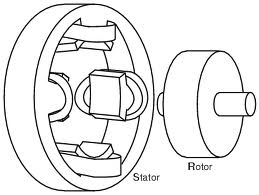Squirrel-cage Rotor:
A squirrel-cage induction motor rotor contains a series of conducting bars laid into slots carved in the face of the rotor and shorted at either end by high shorting rings. The squirrel cage rotor is simple, more rugged and cheaper than wound rotors.

Figure: Wound Rotor of Poly Phase Induction Motor
A wound rotor contains a complete set of three-phase windings that are the mirror images of the windings on the stator. The three-phases of the rotor windings are generally, Y-connected, and the ends of the three rotor wires are ties to slip rings on the rotor's shaft. Therefore wound rotor induction motors have their rotor currents accessible at the stator brushes, where they may be examined and where extra resistance may be inserted into the rotor circuit.
Wound rotor induction motors are more costly than squirrel-cage induction motors and they need more maintenance due to the wear associated with their brushes and slip rings.
Thus on the basis of rotors construction, the induction motors are classified as :
1. Squirrel-cage induction motor.
2. Phase wound or slip ring induction motor.